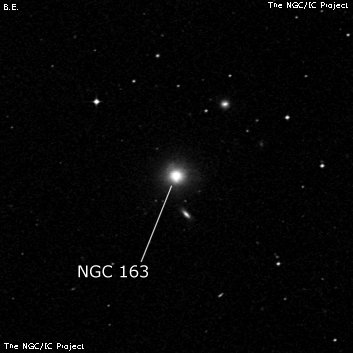
Heinrich d'Arrest discovered NGC 163 on 20 Sep 1865 with the 11-inch refractor at Copenhagen. His mean position (also measured on the next night) matches MCG -02-02-066 = PGC 2149. Although William Herschel's H. III-954 is equated with NGC 163, his observation more likely applies to NGC 165 (see that number). d'Arrest noted the 32 second discrepancy between his RA for NGC 163 and that of H. III-953, but surprisingly d'Arrest didn't record NGC 165, so didn't make the connection between H. III-953 and NGC 165.
Lewis Swift independently found NGC 163 on 9 Aug 1886 and recorded it in his 4th discovery list (#3). Swift's RA was 14 seconds too large and falls between NGC 163 and 165. Harold Corwin notes that Swift's positions for three other galaxies he observed on this night (NGC 153, 217 and 7774) are all 10 - 15 seconds of time too large. Based on a photograph taken with the Crossley reflector between 1912-13, Heber Curtis described NGC 163 as "Almost stellar; structureless; bright nucleus. A very faint spindle is 1.5' s.p.
400/500mm - 17.5" (9/17/88): fairly faint, small, round, brighter core, stellar nucleus, diffuse halo. Forms a pair with NGC 165 6' E.
600/800mm - 24" (8/29/19): at 375x; moderately bright, fairly small, round, well concentrated with a small bright core and stellar nucleus. The halo drops off quickly in surface brightness. It was obvious only to 30" and ~45" diameter with averted vision. In a trio with NGC 165 7' E and MCG -02-02-064 14' N. NGC 163 and 165 form an equilateral triangle with a mag 9.6 star to the north.
Notes by Steve Gottlieb